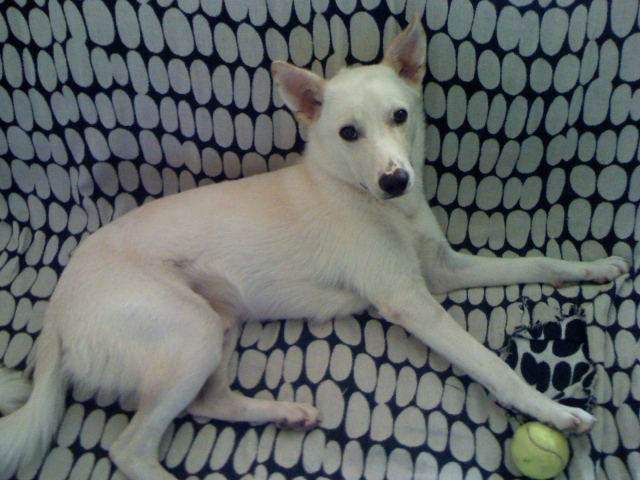QuestionOk, so when you say that you need more description, I assume that you mean with the 'snapping' that Eva is doing. I really do not know how else to explain it, other than she makes a loud noise with her mouth when she 'snaps' it shut really hard. She does this at Max and other people. She comes right up to us and does it. I do not think that it is fear. Why would she come to us if it were fear??? Also, why do you have the feeling that she isn't really a foxhound? And, if you are not supposed to leave a dog in a crate for the night or longer than just a little while, what are we supposed to do with her? If we leave her in the room during the night or while we are not there, she will eat and chew on everything we own. I'm sorry if you feel as if we are being bad by leaving our dogs in crates, but everyone that I know that has a dog does the same thing. It isn't punishment and I have never heard not to do this.
AnswerThere's no need at all to become defensive. I ask questions of people because I need more information to give you an informed opinion. Regarding the crate, this is a containment device that should be used sparingly, as it does not teach the dog anything but does isolate the dog and create a great deal of anxiety. climb into the crate and stay there for an hour. Tell me how you feel. I understand the dog may be destructive when out of the crate and alone. This is most likely a separation anxiety issue and ONE of the reasons she was in the shelter to begin with. Most shelter dogs are there for a reason. If they were all perfectly behaved, marvelous companions like "Lassie" their owners would not have dumped them or surrendered them. Quite often, adopting parties see the reasons the puppy or adult dog was dumped within the first three weeks after adoption. The reason I say I doubt she's a Foxhound is that there are very few purebred American or English Foxhounds dumped into kill (municipal) shelters. It's more likely she's a mixed breed that resembles a Fox hound. This does NOT mean anything in and of itself; the Foxhound is a strong pack animal and aggression from fear or dominance (dominance being definitely not your dog's problem) is rare in that breed.
What you are describing is fear aggression in a very immature manner and/or a puppy with absolutely no idea how to interact appropriately with her own kind or with humans. Whether or not you agree with that determination isn't the point; you asked me, as an expert in aggression, to determine what's happening. My explanation from your description (not being privy to an in person evaluation of your puppy) is that she appears to be demonstrating a fear response. This might also be a dog very undersocialized to other dogs, despite what the shelter workers told you. Because a dog can seem to 'get along' with other dogs in a municipal shelter environment means absolutely nothing. NO behavior from any dog in such an environment is an indication of temperament. The shelter environment is frightening and confusing to all dogs. You aren't going to get a true read on a dog's temperament in such a place, and very few shelter workers are in any way capable to determine same.
What you must do is allow Max to handle his end of this situation in his own way, unless this erupts into Max responding with a strong aggressive response that causes injury. YOU must undertake a different approach. First, learn about positive reinforcement training by reading karen Pryor's site and Patricia McConnell Ph.D.'s book on that subject. Begin to TEACH this young dog one behavior at a time, using positive reinforcement, slowly over the course of the next few weeks, so that she is equipped with a behavior YOU CAN REWARD. Every time she "snaps" as you describe, get up and TURN YOUR BACK on her for ten seconds; turn back again and give her another opportunity to interact with you. IF you TURN YOUR BACK every single time she demonstrates this behavior, she will quickly learn that it is "punishing" (because you withdraw immediately); IF you have also been teaching her a behavior your CAN REWARD, ask her for it when you turn back to her. Remember it takes approximately 36 trials to obtain a conditioned response to any command and don't expect her to be able to do the "sit" (using another word) command on the spot after only a few sessions. Once she has learned that you WITHDRAW when she "snaps" and has learned that responding to your new command (for reward) WORKS for her AND for you, she will calm down, feel more secure and be a better companion.
Don't expect "instant pet". I don't care HOW many people you know who use crates. If all the parents in the your neighborhood decided to allow their ten year old sons to go on an unsupervised camping trip into the woods, WOULD YOU LET YOUR SON GO? The crate must be used sparingly; the dog must be made to feel secure and safe in your home, meaning she receives consistent, fair treatment; affection; leadership and is being taught things she can do to please you. Using the crate to confine the dog until she has obtained the maturity and stability she requires is ok so long as she is not confined unfairly, left to rot in the crate day and night.

 uncontrollable beagle
Question
max
My beagle is a year and a half. Ive had hi
uncontrollable beagle
Question
max
My beagle is a year and a half. Ive had hi
 Agressive 1 yr old mini goldendoodle
Question
our millie
My husband and I got our min
Agressive 1 yr old mini goldendoodle
Question
our millie
My husband and I got our min
 Dog walking problems
Question
Snickers
I have been trying to train my dog SN
Dog walking problems
Question
Snickers
I have been trying to train my dog SN
 agressive silky terrier
Question
Lucas 1 year old
Hi Jennifer:
I have a
agressive silky terrier
Question
Lucas 1 year old
Hi Jennifer:
I have a
 Dog light and shadow chasing
Question
Jenni
My 3 year old Cavalier King Charles Span
Dog light and shadow chasing
Question
Jenni
My 3 year old Cavalier King Charles Span